Gray wolf
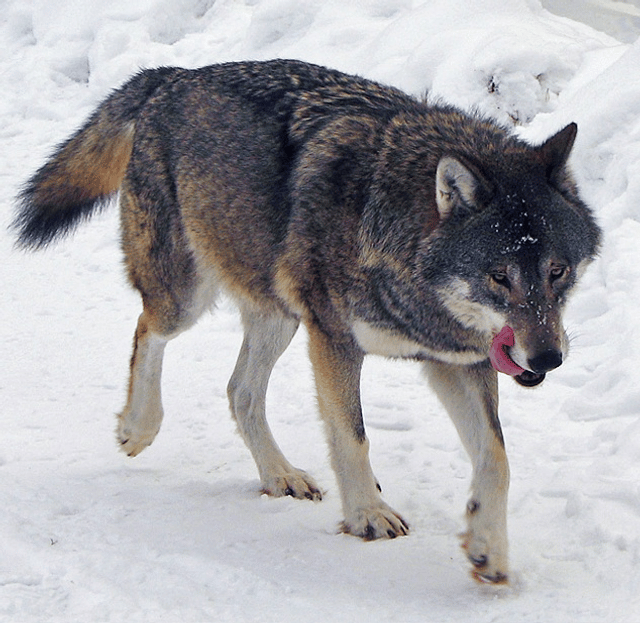
Gray wolf

| Wolf | |
|---|---|
| Eurasian wolf(Canis lupus lupus). | |
| Wolf pack howling | |
| Scientific classification | |
| Kingdom: | Animalia |
| Phylum: | Chordata |
| Class: | Mammalia |
| Order: | Carnivora |
| Family: | Canidae |
| Genus: | Canis |
| Species: | |
| Binomial name | |
| Canis lupus | |
| Subspecies | |
| referSubspecies of Canis lupus | |
| Historical (red + green) and modern (green) range of wild subspecies ofC. lupus.More recent evidence suggests the wolf range extends across all of mainland China,[4][5][6]and in the US down theCascade Rangefrom British Columbia through Washington State,[7]Oregon State,[8]and northern California[9]toLassen Peak. | |
The wolf (Canis lupus), also known as the gray/grey wolf, is a canine native to the wilderness and remote areas of Eurasia and North America. It is the largest extant member of its family, with males averaging 43–45 kg (95–99 lb) and females 36–38.5 kg (79–85 lb). It is distinguished from other Canis species by its larger size and less pointed features, particularly on the ears and muzzle. Its winter fur is long and bushy and predominantly a mottled gray in color, although nearly pure white, red and brown to black also occur. Mammal Species of the World (3rd ed., 2005), a standard reference work in zoology, recognises 38 subspecies of C. lupus.
The wolf is the most specialized member of the genus Canis in the direction of cooperative big game hunting, as demonstrated by its morphological adaptations to tackling large prey, its more gregarious nature, and its highly advanced expressive behavior. It is nonetheless closely related enough to smaller Canis species, such as the coyote and golden jackal, to produce fertile hybrids. It is the only species of Canis to have a range encompassing both Eurasia and North America, and originated in Eurasia during the Pleistocene, colonizing North America on at least three separate occasions during the Rancholabrean. It is a social animal, travelling in nuclear families consisting of a mated pair, accompanied by the pair's adult offspring. The wolf is typically an apex predator throughout its range. It feeds primarily on large wild ungulates, though it also eats smaller animals, livestock, carrion, and garbage. A seven-year-old wolf is considered to be relatively old, and the maximum lifespan is about 16 years.
The global wolf population is estimated to be 300,000.
The wolf is one of the world's best-known and most-researched animals, with probably more books written about it than any other wild species.
It has a long history of association with humans, having been despised and hunted in most pastoral communities because of its attacks on livestock, while conversely being respected in some agrarian and hunter-gatherer societies. Although the fear of wolves is pervasive in many human societies, the majority of recorded attacks on people have been attributed to animals suffering from rabies. Non-rabid wolves have attacked and killed people, mainly children, but this is rare, as wolves are relatively few, live away from people, and have developed a fear of humans from hunters and shepherds.
| Wolf | |
|---|---|
| Eurasian wolf(Canis lupus lupus). | |
| Wolf pack howling | |
| Scientific classification | |
| Kingdom: | Animalia |
| Phylum: | Chordata |
| Class: | Mammalia |
| Order: | Carnivora |
| Family: | Canidae |
| Genus: | Canis |
| Species: | |
| Binomial name | |
| Canis lupus | |
| Subspecies | |
| referSubspecies of Canis lupus | |
| Historical (red + green) and modern (green) range of wild subspecies ofC. lupus.More recent evidence suggests the wolf range extends across all of mainland China,[4][5][6]and in the US down theCascade Rangefrom British Columbia through Washington State,[7]Oregon State,[8]and northern California[9]toLassen Peak. | |
Etymology
The English 'wolf' stems from the Old English wulf, which is itself thought to be derived from the Proto-Germanic wulfazLatin lupus is a Sabine loanword.[10] Both derive from the Proto-Indo-European root ** wĺ̥kʷos or *lúkʷos wulf as a prefix or suffix in their names. Examples include Wulfhere, Cynewulf, Ceonwulf, Wulfheard, Earnwulf, Wulfmǣr, Wulfstān and Æthelwulf. Wolf-related names were also common among pre-Christian Germanic warriors: Wolfhroc (Wolf-Frock), Wolfhetan (Wolf Hide), Isangrim (Grey Mask), Scrutolf (Garb Wolf), Wolfgang (Wolf Gait) and Wolfdregil (Wolf Runner).[12]
Taxonomy
The species Canis lupus was named by the Swedish botanist and zoologist Carl Linnaeus in his publication Systema Naturae in 1758.[3] The nominate subspecies is the Eurasian wolf (Canis lupus lupus), based on the type specimen that Linnaeus studied in Sweden. The 38 subspecies of Canis lupus are listed under the biological common name of "wolf" in Mammal Species of the World (3rd edition) that was published in 2005. The domestic dog is listed as a subspecies, and the dingo, together with the New Guinea singing dog, form another subspecies.[13]
Evolution
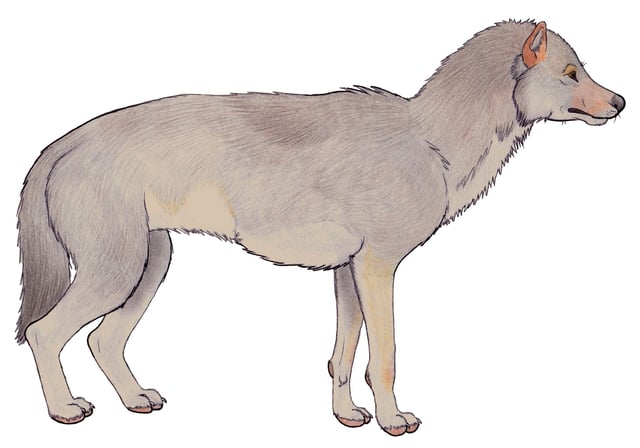
Artist's impression of a Beringian wolf
The earliest fossils of Canis lupus were found in what was once eastern Beringia at Old Crow, Yukon, Canada and at Cripple Creek Sump, Fairbanks, Alaska. The age is not agreed but could date 1 million YBP. Considerable morphological diversity existed among grey wolves by the Late Pleistocene. These are regarded as having been more cranio-dentally robust than modern grey wolves, often with a shortened rostrum, the pronounced development of the temporalis muscle, and robust premolars. It is proposed that these features were specialized adaptations for the processing of carcass and bone associated with the hunting and scavenging of Pleistocene megafauna. Compared with modern wolves, some Pleistocene wolves showed an increase in tooth breakage that is similar to that seen in the extinct dire wolf. This suggests that these either often processed carcasses, or that they competed with other carnivores and needed to quickly consume their prey. The frequency and location of tooth fractures found in these wolves, compared with the modern spotted hyena, indicates that these wolves were habitual bone crackers.[14]
This continuous wolf presence contrasts with genomic studies, which suggest that all modern wolves and dogs descend from a common ancestral wolf population[15][16][17] that existed as recently as 20,000 years ago.[15] These studies indicate that a population bottleneck was followed by a rapid radiation from an ancestral population at a time during, or just after, the Last Glacial Maximum. This implies that the original wolf populations were out-competed by a new type of wolf which replaced them.[18] However, the geographic origin of this radiation is not known.
Population structure
The wolf is a highly adaptable species that is able to exist in a range of environments and which possesses a wide distribution across the Holarctic. Studies of modern wolves have identified distinct sub-populations that live in close proximity to each other.[19][20] This variation in sub-populations is closely linked to differences in habitat – precipitation, temperature, vegetation, and prey specialization – which affect cranio-dental plasticity.[21][22][23][24]
The wolf population in Europe is divided along a north-south axis and forms five major clusters.
Three clusters occupy Italy, the Dinaric-Balkans, and the Carpathians. Another two clusters occupy north-central Europe and the Ukrainian steppe. The Italian wolf consisted of an isolated population with low genetic diversity. Wolves from Croatia, Bulgaria, and Greece form the Dinaric-Balkans cluster. Wolves from Finland, Latvia, Belarus, Poland and Russia form the north-central Europe cluster, with wolves from the Carpathians cluster coming from a mixture of wolves from the north-central cluster and the Dinaric-Balkans cluster. The wolves from the Carpathians are more similar to the wolves from the Pontic-Caspian Steppe than they are to wolves from north-central Europe. These clusters may be the result of their expansions from glacial refugia, an adaptation to local environments, or landscape fragmentation and the killing of wolves in some areas by humans.[25]
The wolf population in North American forms six ecotypes – genetically and ecologically distinct populations separated from other populations by their different type of habitat. These six ecotypes were named West Forest, Boreal Forest, Arctic, High Arctic, Baffin, and British Columbia. The studies found that precipitation and mean diurnal temperature range were the most influential variables on the formation of these ecotypes.[20][26] The local adaptation of a wolf ecotype reflects a wolf's preference to remain in the type of habitat that it was born into.[20]
Admixture with other canids
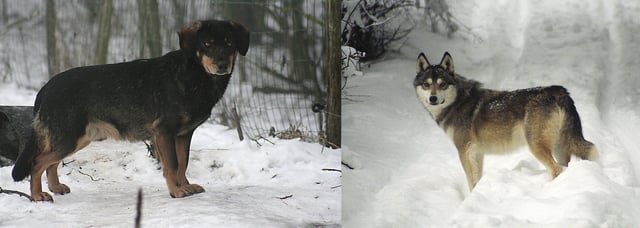
Wolf-dog hybrids. The first is the product of a male wolf and a female spaniel, the second from a female wolf and a male West Siberian Laika
The wolf-like canids are a group of large carnivores that are closely related because their chromosomes number 78,[27][28][29] and therefore they can potentially interbreed.[30] In the distant past there has been gene flow between African golden wolves, golden jackals, and wolves. The African golden wolf is a descendant of a genetically admixed canid of 72% wolf and 28% Ethiopian wolf ancestry. One African golden wolf from the Egyptian Sinai Peninsula shows admixture with the Middle Eastern wolves and dogs. There is evidence of gene flow between golden jackals and Middle Eastern wolves, less so with European and Asian wolves, and least with North American wolves. This indicates that the golden jackal ancestry found in North American wolves may have occurred before the divergence of the Eurasian and North American wolves. The common ancestor of the coyote and the wolf has admixed with a ghost population of an extinct unidentified canid. This canid is genetically close to the dhole and has evolved after the divergence of the African hunting dog from the other canid species. The basal position of the coyote compared to the wolf is proposed to be due to the coyote retaining more of the mitochondrial genome of this unidentified canid.[31] In North America, most coyotes and wolves show varying degrees of past genetic admixture.[32] Black-colored wolves in North America acquired their coloration from wolf-dog admixture after the first arrival of dogs.[33]
In more recent times some male Italian wolves originated from dog ancestry, which indicates that female wolves will breed with male dogs in the wild.[34] 10 percent of dogs in the Caucasus Mountains, including livestock guardian dogs, are first generation hybrids.[35] Although mating between golden jackals and wolves has never been observed, evidence of jackal-wolf hybridization was discovered through mitochondrial DNA analysis of jackals living in the Caucasus Mountains.[35] and in Bulgaria.[36]
Description

Differences between the wolf and coyote

Wolf skeleton
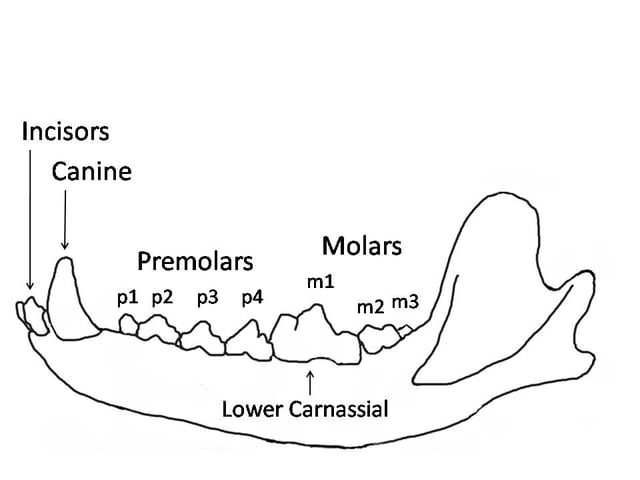
Wolf mandible diagram showing the names and positions of the teeth.
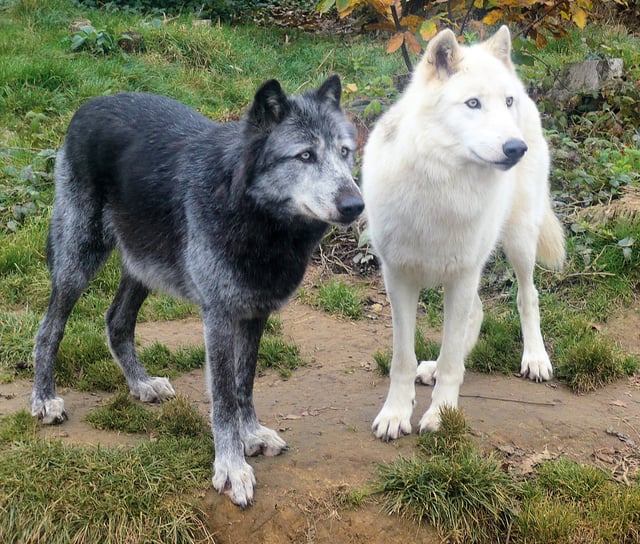
Black and white captive wolves in France
The wolf is the largest member of the Canidae family.[37] It is similar to its closest wild cousins the coyote and the golden jackal but is distinguished by being larger and heavier, with a broader snout, shorter ears, a shorter torso and a longer tail.[38][37] It is slender and powerfully built with a large, deeply descending rib cage, a sloping back, and a heavily muscled neck.[39] The wolf's legs are moderately longer than those of other canids, which enables the animal to move swiftly, and allows it to overcome the deep snow that covers most of its geographical range.[40] The ears are relatively small and triangular.[39] Females tend to have narrower muzzles and foreheads, thinner necks, slightly shorter legs and less massive shoulders than males.[41]
On average, adult wolves measure 105–160 cm (41–63 in) in length and 80–85 cm (31–33 in) at shoulder height.
[39] The tail measures 29–50 cm (11–20 in) in length, the ears 90–110 mm (3.5–4.3 in) in height, and the hind feet are 220–250 mm (8.7–9.8 in).[39] Wolf weight and size increase proportionally with latitude in accord with Bergmann's rule.[39] The mean body mass of the wolf is 40 kg (88 lb), with the smallest specimen recorded at 12 kg (26 lb) and the largest at 79.4 kg (175 lb).[42][39] On average, European wolves may weigh 38.5 kg (85 lb), North American wolves 36 kg (79 lb), and Indian and Arabian wolves 25 kg (55 lb).[43] Females in any given wolf population typically weigh 5–10 lb (2.3–4.5 kg) less than males.[44] Wolves weighing over 54 kg (119 lb) are uncommon, though exceptionally large individuals have been recorded in Alaska, Canada,[44] and the forests of western Russia.[39] The heaviest wolf to be taken by the United States Fish and Wildlife Service was killed on 70 Mile River in east-central Alaska on July 12, 1939 and weighed 79.4 kg (175 lb).[45]
The wolf usually travels at a loping pace, placing its paws one directly in front of the other.
This gait can be maintained for hours at a rate of 8–9 km/h (5.0–5.6 mph),[46] which allows the wolf to cover great distances.
On bare paths, a wolf can quickly achieve speeds of 50–60 km/h (31–37 mph).
The wolf has a running gait of 55–70 km/h (34–43 mph), can leap 5 m (16 ft) horizontally in a single bound, and can maintain rapid pursuit for at least 20 minutes.[47]
The wolf usually carries its head at the same level as the back, raising it only when alert.[39] Its head is large and heavy, with a wide forehead, strong jaws and a long, blunt muzzle.[39] The skull averages 230–280 mm (9.1–11.0 in) in length and 130–150 mm (5.1–5.9 in) in width.[48] The teeth are heavy and large, which are better suited to crushing bone than those of other canids, although not as specialised as those found in hyenas.[49][50] Its molars have a flat chewing surface but not to the same extent as the coyote, whose diet contains more vegetable matter.[51]
| Canid | Carnassial | Canine |
|---|---|---|
| Wolf | 131.6 | 127.3 |
| Dhole | 130.7 | 132.0 |
| African wild dog | 127.7 | 131.1 |
| Greenland dogandDingo | 117.4 | 114.3 |
| Coyote | 107.2 | 98.9 |
| Side-striped jackal | 93.0 | 87.5 |
| Golden jackal | 89.6 | 87.7 |
| Black-backed jackal | 80.6 | 78.3 |
The wolf has very dense and fluffy winter fur, with short underfur and long, coarse guard hairs.[39] Most of the underfur and some of the guard hairs are shed in the spring and grow back in the autumn period.[43] The longest hairs occur on the back, particularly on the front quarters and neck. Especially long hairs are on the shoulders, and almost form a crest on the upper part of the neck. The hairs on the cheeks are elongated and form tufts. The ears are covered in short hairs, which strongly project from the fur. Short, elastic and closely adjacent hairs are present on the limbs from the elbows down to the calcaneal tendons.[39] The winter fur is highly resistant to the cold, and wolves in northern climates can rest comfortably in open areas at −40 °C (−40 °F) by placing their muzzles between the rear legs and covering their faces with their tail. Wolf fur provides better insulation than dog fur, and does not collect ice when warm breath is condensed against it.[43] In warm climates, the fur is coarser and scarcer than in northern wolves.[39] Female wolves tend to have smoother furred limbs than males, and generally develop the smoothest overall coats as they age. Older wolves generally have more white hairs in the tip of the tail, along the nose and on the forehead. The winter fur is retained longest by lactating females, although with some hair loss around their nipples.[41] Hair length on the middle of the back is 60–70 mm (2.4–2.8 in),and the guard hairs on the shoulders generally does not exceed 90 mm (3.5 in) but can reach 110–130 mm (4.3–5.1 in).[39]
Coat color ranges from almost pure white through various shades of blond, cream and ochre to grays, browns and blacks,[53] with variation in fur color tending to increase in higher latitudes.[54] Differences in coat color between sexes are largely absent,[39] although females may have redder tones.[55]
Adaptation
Distribution and habitat
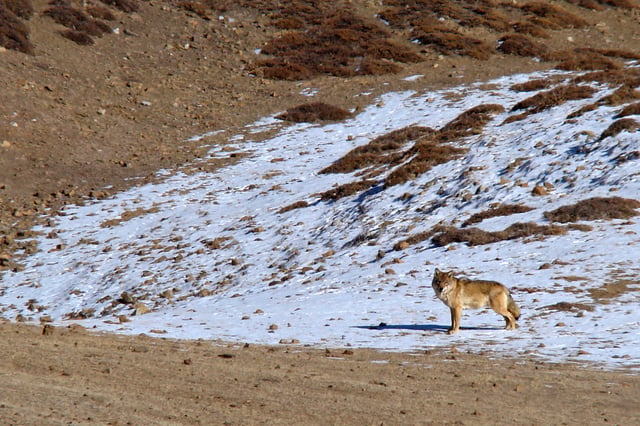
Wolf in mountainous habitat in Himachal Pradesh's Spiti Valley, India
Originally, wolves occurred across Eurasia above the 12th parallel north and across North America above the 15th parallel north. However, deliberate human persecution has reduced the wolf's range to about one-third of what it once was because of livestock predation and fear of attacks on humans. The wolf is now extirpated (made locally extinct) in much of Western Europe, in Mexico and much of the United States. In modern times, the wolf occurs mostly in wilderness and remote areas, particularly in Canada, Alaska and the northern United States, Europe and Asia from about 75°N to 12°N.[2] The wolf can be found between sea level and 3,000 metres (9,800 ft). It lives in forests, inland wetlands, shrublands, grasslands including arctic tundra, pastures, deserts, and rocky peaks on mountains.[2] Habitat use by wolves is strongly correlated with the abundance of prey, snow conditions, absence or low livestock densities, road densities, human presence and topography.[51] In cold climates, the wolf can reduce the flow of blood near its skin to conserve body heat. The warmth of the footpads is regulated independently of the rest of the body, and is maintained at just above tissue-freezing point where the pads come in contact with ice and snow.[56]
Diet
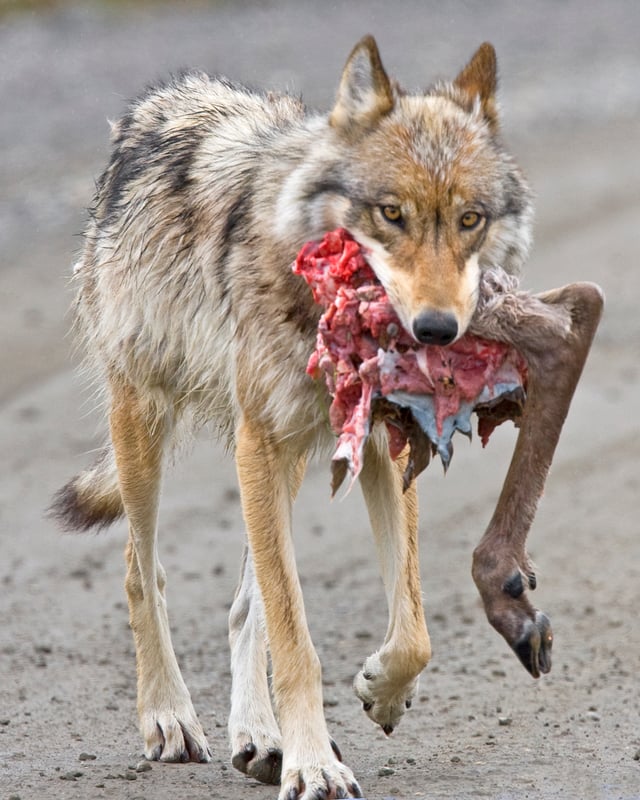
Wolf carrying caribou hindquarter, Denali National Park, Alaska
Like all land mammals that are pack hunters, the wolf predominantly feeds on herbivorous mammals that have a body mass similar to that of the combined mass of the pack members.[57][58] The wolf specializes in preying on the vulnerable individuals of large prey,[51] with a pack of timber wolves being capable of bringing down a 500 kg (1,100 lb) moose.[59] Wolves can digest their meal in a few hours and can feed several times in one day, making quick use of large quantities of meat.[60] A well-fed wolf stores fat under the skin, around the heart, intestines, kidneys, and bone marrow, particularly during the autumn and winter.[61]
Across their range, wolves predominantly feed on wild ungulates that can be divided into large size 240–650 kg (530–1,430 lb) and medium size 23–130 kg (51–287 lb). The variation in diet between wolves living on different continents is based on the different varieties of ungulate species and of smaller and domestic prey that are available. In North America, the wolf's diet is dominated by wild large ungulates and medium-sized mammals. In Asia and Europe, their diet is dominated by wild medium sized ungulates and domestic species. The wolf depends on wild ungulates, and if these are not readily available, as in Asia, the wolf is more reliant on domestic species.[62] Across Eurasia, wolves prey mostly on moose, red deer, roe deer and wild boar.[63] In North America, important prey rangewide are elk, moose, caribou, white-tailed deer and mule deer.[64]
Although wolves primarily feed on medium to large sized ungulates, they are not fussy eaters.
Smaller sized animals that may supplement the diet of wolves include rodents, hares, insectivores and smaller carnivores. They frequently eat waterfowl and their eggs. When such foods are insufficient, they prey on lizards, snakes, frogs, and large insects as available.[65] Wolves in northern Minnesota prey on northern pike in freshwater streams.[66] The diet of coastal wolves in Alaska includes 20 percent salmon,[67] while coastal wolves in British Columbia includes 25 percent marine sources and those on the nearby islands 75 percent.[68]
In Europe, wolves eat apples, pears, figs, mellons, berries and cherries. In North America, wolves eat blueberries and raspberries. Wolves also eat grass, which may provide some vitamins.[69] They are known to eat the berries of mountain ash, lily of the valley, bilberries, cowberry, nightshade, grain crops, and the shoots of reeds.[65]
In times of scarcity, wolves will readily eat carrion.[65] In Eurasian areas with dense human activity, many wolf populations are forced to subsist largely on livestock and garbage.[63] The prey animals of North American wolves have largely continued to occupy suitable habitats with low human density, and cases of wolves subsisting largely on garbage or livestock are exceptional.[70] Cannibalism is not uncommon in wolves during harsh winters, when packs often attack weak or injured wolves, and may eat the bodies of dead pack members.[65][71][72]
Behavior
Social behavior
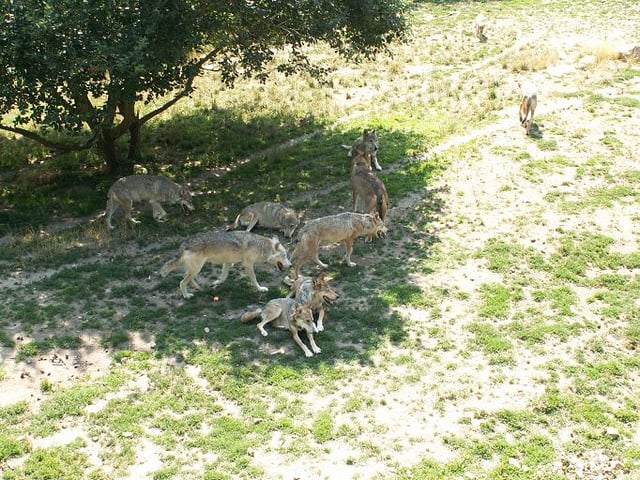
Italian wolf pack resting in shade
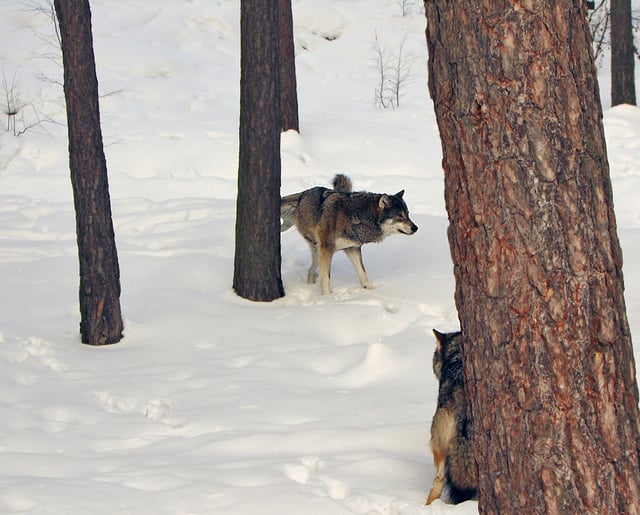
Wolf marking its territory with urine
The wolf is a social animal, whose basic social unit consists of a mated pair accompanied by their adult offspring.
The average pack consists of a family of five to eleven wolves (two adults, three to six juveniles, and one to three yearlings),[73] or sometimes two or three such families,[51] with exceptionally large packs consisting of up to forty-two wolves being known.[74] In ideal conditions, the mated pair produces pups every year, with such offspring typically staying in the pack for 10–54 months before dispersing.[75] Triggers for dispersal include the onset of sexual maturity and competition within the pack for food.[76] The distance travelled by dispersing wolves varies widely; some stay in the vicinity of the parental group, while other individuals may travel great distances of 206 km (128 mi), 390 km (240 mi), and 670 km (420 mi) from their natal packs.[47] A new pack is usually founded by an unrelated dispersing male and female, travelling together in search of an area devoid of other hostile packs.[77] Cortisol levels in wolves rise significantly when a pack member dies, indicating the presence of stress.[78] Wolf packs rarely adopt other wolves into their fold, and typically kill them. In the rare cases where other wolves are adopted, the adoptee is almost invariably an immature animal of one to three years of age and unlikely to compete for breeding rights with the mated pair. In some cases, a lone wolf is adopted into a pack to replace a deceased breeder.[74] During times of ungulate abundance caused through calving or migration, different wolf packs may temporarily join together.[73]
Wolves are highly territorial and generally establish territories far larger than they require in order to survive, which assures a steady supply of prey. Territory size depends largely on the amount of prey available and the age of the pack's pups, tending to increase in size in areas with low prey populations,[79] or when the pups reach the age of six months when they have the same nutritional needs as adults.[80] Wolf packs travel constantly in search of prey, covering roughly 9% of their territory per day (average 25 km/d (16 mi/d)). The core of their territory is on average 35 km2 (14 sq mi), in which they spend 50% of their time.[79] Prey density tends to be much higher in their territory's surrounding areas, although wolves tend to avoid hunting on the fringes of their range unless desperate because of the possibility of fatal encounters with neighboring packs.[81] The smallest territory on record was held by a pack of six wolves in northeastern Minnesota, which occupied an estimated 33 km2 (13 sq mi), while the largest was held by an Alaskan pack of ten wolves encompassing a 6,272 km2 (2,422 sq mi) area.[80] Wolf packs are typically settled, and usually only leave their accustomed ranges during severe food shortages.[73]
Wolves advertise their territories to other packs through howling and scent marking. Scent marking involves urine, feces, and anal gland scents. Scent marking is more effective at advertising territory than howling, and is often used in combination with scratch marks. Wolves increase their rate of scent marking when they encounter the scent marks of wolves from other packs. Lone wolves will rarely scent mark, but newly bonded pairs will scent mark the most.[51] Scent marks are generally left every 240 m (260 yd) throughout the territory on regular travelways and junctions. Such markers can last for two to three weeks,[80] and are typically placed near rocks, boulders, trees, or the skeletons of large animals.[73] Territorial fights are among the principal causes of wolf mortality, with one study concluding that 14–65% of wolf deaths in Minnesota and the Denali National Park and Preserve were due to predation by other wolves.[82]
Wolves communicate to anticipate what their packmates or other wolves might do next.[83] It includes the use of vocalization, body posture, scent, touch, and taste.[84] The phases of the moon have no effect on wolf vocalisation, and despite popular belief wolves do not howl at the moon.[85] Wolves howl to assemble the pack usually before and after hunts, to pass on an alarm particularly at a den site, to locate each other during a storm or while crossing unfamiliar territory, and to communicate across great distances.[77] Other vocalisations include growls, barks and whines.[87] Wolves do not bark as loudly or continuously as dogs do but they bark a few times and then retreat from a perceived danger.[87] Aggressive or self-assertive wolves are characterized by their slow and deliberate movements, high body posture and raised hackles, while submissive ones carry their bodies low, sleeken their fur, and lower their ears and tail.[88] Raised leg urination is considered to be one of the most important forms of scent communication in the wolf, making up 60–80% of all scent marks observed.[89]
Reproduction
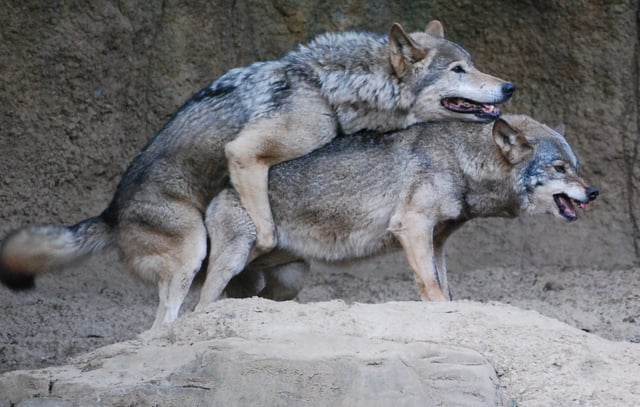
Korean wolves mating

Illustrated growth stages of the northwestern wolf: newborn, three weeks old, two months old, and one-year-old adult
The foundation of a wolf pack is the mated pair.
Known uncommon variations include a mature male and two mature females, a mature male and his mate along with his yearling son from a previous mating, and a mature female with a new mate and his younger brother.
One unusual pack from Yellowstone was formed by twelve dispersers from four other packs.
Packs may include offspring from up to four years of breeding, with one pack consisting of forty-two wolves.[90] The wolf is monogamous, with mated pairs usually remaining together for life. Should one of the pair die, another mate is quickly found. Males form a majority in the wolf pack, with unpaired females being rare.[91] In favorable conditions, there are sometimes more than one breeding pair within the natal pack. This pair may later move into an area adjacent to, or overlapping with, the pack territory. Some wolves may leave the pack but remain in the pack's territory, waiting for one of the breeding parents to perish before they can breed. Most foreign mature wolves are killed by the pack unless the pack needs to replace a breeder. Sometimes a foreign wolf will be adopted and provided with alloparental care by a pack that already has a breeding pair, and this usually occurs between the months of February and May. These adopted wolves are usually male and between the age of one to three years old. Adoptee males may mate with an available pack female to then form their own pack.[92] With wolves in the wild, inbreeding does not occur where outbreeding is possible.[93]
Wolves become mature at the age of two years, and sexually mature from the age of three years.[91] The age of first breeding in wolves depends largely on environmental factors: when food is plentiful, or when wolf populations are heavily managed, wolves can rear pups at younger ages in order to better exploit abundant resources.
Females are capable of producing pups every year, with one litter annually being the average. Unlike the coyote, the wolf never reaches menopause.[94] Estrus commences in female wolves and the rut begins in the second half of winter, when the pack disperses. Adults disperse first, then yearlings, then juveniles. The pack later reunites but stays away from the breeding pair. Estrus lasts for two weeks.[91]
Dens are usually constructed for pups during the summer period.
When building dens, females make use of natural shelters such as fissures in rocks, cliffs overhanging riverbanks and holes thickly covered by vegetation.
Sometimes, the den is the appropriated burrow of smaller animals such as foxes, badgers or marmots.
An appropriated den is often widened and partly remade.
On rare occasions, female wolves dig burrows themselves, which are usually small and short with one to three openings.
The den is usually constructed not more than 500 m (550 yd) away from a water source, and typically faces southwards where it can be better warmed by sunlight exposure, and the snow more-quickly thawing.
Resting places, play areas for the pups and food remains are commonly found around wolf dens.
The odour of urine and rotting food emanating from the denning area often attracts scavenging birds such as magpies and ravens. As there are few convenient places for burrows, wolf dens are usually occupied by animals of the same family. Though they mostly avoid areas within human sight, wolves have been known to nest near domiciles, paved roads and railways.[95] During pregnancy, female wolves remain in a den located away from the peripheral zone of their territories, where violent encounters with other packs are more likely to occur.[96]
The gestation period lasts 62–75 days with pups usually being born in the spring months, or early summer in very cold places such as on the tundra. Young females give birth with 4-5 young, and older females from 6-8 young and up to 14 young. Their mortality rate is 60-80 percent.[97] Pups are born blind and deaf, and are covered in short soft grayish-brown fur. They weigh 300–500 g (11–18 oz) at birth, and begin to see after nine to 12 days. The milk canines erupt after one month. Pups first leave the den after three weeks. At 1.5 months of age, they are agile enough to flee from danger. Mother wolves do not leave the den for the first few weeks, relying on the fathers to provide food for them and their young. Pups begin to eat solid food at the age of three to four weeks. Pups have a fast growth rate during their first four months of life: during this period, a pup's weight can increase nearly 30 times.[97][98] Wolf pups begin play-fighting at the age of three weeks, though unlike young coyotes and foxes, their bites are gentle and controlled. Actual fights to establish hierarchy usually occur at five to eight weeks of age. This is in contrast to young coyotes and foxes, which may begin fighting even before the onset of play behavior.[99] By autumn, the pups are mature enough to accompany the adults on hunts for large prey.[96]
Foraging

American bison standing its ground against a pack of wolves, thus increasing its chances of survival
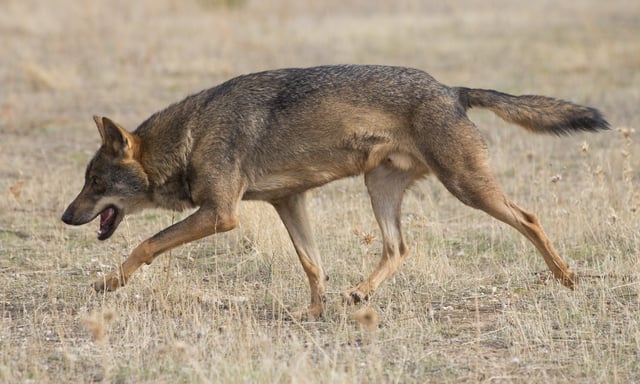
Iberian wolf trotting in summer fur. They generally place their hind paws in the tracks made by the front paws.[40]
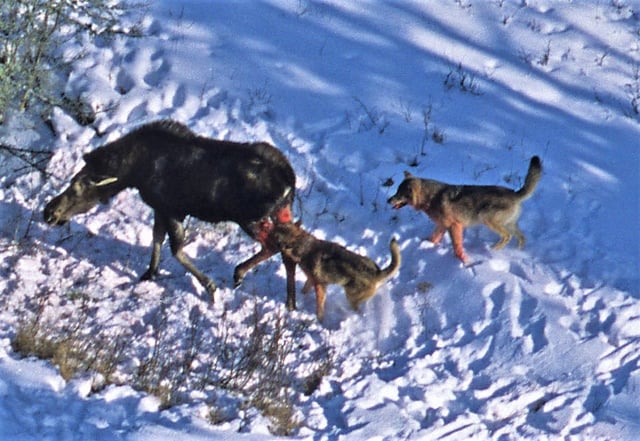
Two wolves killing a moose in typical fashion: biting the hindquarters
Wolves move around their territory when foraging using the same trails for extended periods.
After snowfalls, the wolves find their old trails and continue using them.
The trails follow the banks of rivers, the shorelines of lakes, through ravines overgrown with shrubs or through plantations, and following roads and human paths.[100] Wolves are nocturnal predators in both summer and winter.
During the winter a pack will commence hunting in the twilight of early evening and will hunt all night, travelling tens of kilometres.
Sometimes hunting for wild ungulates occurs during the day.
During the summer, wolves generally tend to hunt individually, ambushing their prey and rarely giving pursuit.[101]
Although social animals, single wolves or mated pairs typically have higher success rates in hunting than do large packs, with single wolves having occasionally been observed to kill large prey such as moose, bison and muskoxen unaided.[102] The wolf's sense of smell is relatively weakly developed when compared to that of some hunting dog breeds, being able to detect carrion upwind no farther than 2–3 kilometres (1.2–1.9 mi). Because of this, it rarely manages to capture hidden hares or birds, though it can easily follow fresh tracks. Its auditory perception is acute enough to be able to hear up to a frequency of 26 kHz,[103] which is sufficient to register the fall of leaves in the autumn period.[73] A wolf hunt can be divided into five stages:
Locating prey: The wolves travel in search of prey through their power of scent, chance encounter, and tracking. Wolves typically locate their prey by scent, though they must usually be directly downwind of it. When a breeze carrying the prey's scent is located, the wolves stand alert, and point their eyes, ears and nose towards their target. In open areas, wolves may precede the hunt with group ceremonies involving standing nose-to-nose and wagging their tails. Once concluded, the wolves head towards their prey.[104]
The stalk: The wolves attempt to conceal themselves as they approach.[105] As the gap between the wolves and their prey closes, the wolves quicken their pace, wag their tails, and peer intently, getting as close to their quarry as possible without making it flee.[106]
The encounter: Once the prey detects the wolves, it can either approach the wolves, stand its ground, or flee. Large prey, such as moose, elk, and muskoxen, usually stand their ground. Should this occur, the wolves hold back, as they require the stimulus of a running animal to proceed with an attack.[107] If the targeted animal stands its ground, the wolves either ignore it, or try to intimidate it into running.[102]
The rush: If the prey attempts to flee, the wolves immediately pursue it. This is the most critical stage of the hunt, as wolves may never catch up with prey running at top speed.[108] If their prey is travelling in a group, the wolves either attempt to break up the herd, or isolate one or two animals from it.[105]
The chase: A continuation of the rush, the wolves attempt to catch up with their prey and kill it.[109] When chasing small prey, wolves attempt to catch up with their prey as soon as possible, while with larger animals, the chase is prolonged, in order to wear the selected prey out. Wolves usually give up chases after 1–2 km (0.62–1.3 mi), though one wolf was recorded to chase a deer for 21 km (13 mi).[102] Both Russian and North American wolves have been observed to drive prey onto crusted ice, precipices, ravines, slopes and steep banks to slow them down.[110]
The actual killing method varies according to prey species.
With large prey, mature wolves usually avoid attacking frontally, instead focusing on the rear and sides of the animal.
Large prey, such as moose, is killed by biting large chunks of flesh from the soft perineum area, causing massive blood loss. Such bites can cause wounds 10–15 cm (3.9–5.9 in) in length, with three such bites to the perineum usually being sufficient to bring down a large deer in optimum health.[110] With medium-sized prey such as roe deer or sheep, wolves kill by biting the throat, severing nerve tracks and the carotid artery, thus causing the animal to die within a few seconds to a minute. With small, mouse-like prey, wolves leap in a high arc and immobilize it with their forepaws.[111] When prey is vulnerable and abundant, wolves may occasionally surplus kill. Such instances are common in domestic animals, but rare in the wild. In the wild, surplus killing primarily occurs during late winter or spring, when snow is unusually deep (thus impeding the movements of prey)[112] or during the denning period, when wolves require a ready supply of meat when denbound.[113] Medium-sized prey are especially vulnerable to surplus killing, as the swift throat-biting method by which they are killed allows wolves to quickly kill one animal and move on to another.[111]
Once prey is brought down, wolves begin to feed excitedly, ripping and tugging at the carcass in all directions, and bolting down large chunks of it.[114] The breeding pair typically monopolizes food in order to continue producing pups.
When food is scarce, this is done at the expense of other family members, especially non-pups.[115] The breeding pair typically eats first, though as it is they who usually work the hardest in killing prey, they may rest after a long hunt and allow the rest of the family to eat unmolested.
Once the breeding pair has finished eating, the rest of the family tears off pieces of the carcass and transport them to secluded areas where they can eat in peace.
Wolves typically commence feeding by consuming the larger internal organs of their prey, such as the heart, liver, lungs and stomach lining. The kidneys and spleen are eaten once they are exposed, followed by the muscles.[116] A single wolf can eat 15–19% of its body weight in a single feeding.[61]
Competition
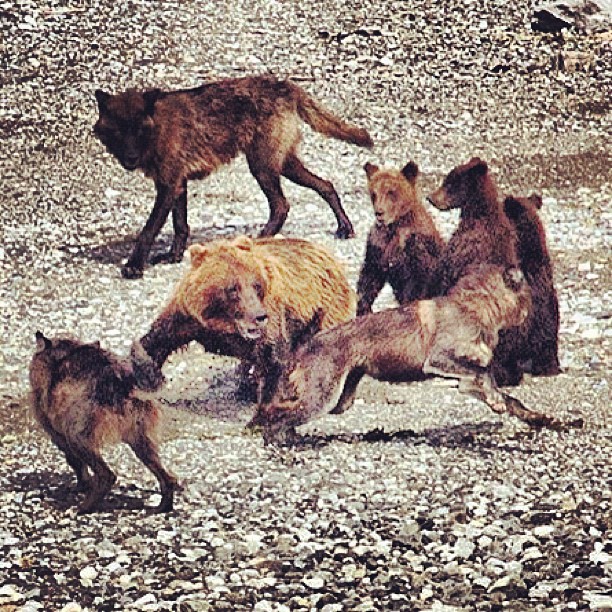
Wolves attacking a mother grizzly bear with cubs
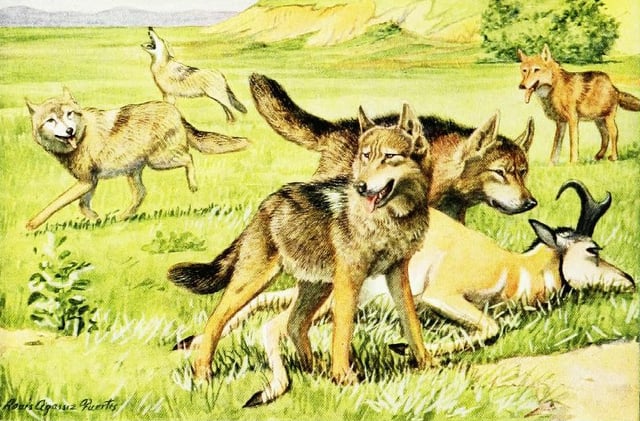
Wolves confronting coyotes over a pronghorn carcass (1919), Louis Agassiz Fuertes
Wolves typically dominate other canid species in areas where they both occur. In North America, incidents of wolves killing coyotes are common, particularly in winter, when coyotes feed on wolf kills. Wolves may attack coyote den sites, digging out and killing their pups, though rarely eating them. There are no records of coyotes killing wolves, though coyotes may chase wolves if they outnumber them.[117][118] Near-identical interactions have been observed in Eurasia between wolves and golden jackals, with the latter's numbers being comparatively small in areas with high wolf densities.[73][117][119] Wolves are the most important predator of raccoon dogs, killing large numbers of them in the spring and summer periods.[73] Wolves also kill red, Arctic and corsac foxes, usually in disputes over carcasses, sometimes eating them.[73][120]
Brown bears typically dominate wolf packs in disputes over carcasses, while wolf packs mostly prevail against bears when defending their den sites. Both species kill each other's young. Wolves eat the brown bears they kill, while brown bears seem to only eat young wolves.[121] Wolf interactions with American black bears are much rarer than with brown bears, because of differences in habitat preferences. Wolves have been recorded on numerous occasions to actively seek out black bears in their dens and kill them without eating them. Unlike brown bears, black bears frequently lose against wolves in disputes over kills.[122] Wolves also dominate and sometimes kill wolverines and will chase off those that attempt to scavenge from their kills. Wolverines escape from wolves in caves or up trees.[123]
Large wolf populations limit the numbers of small to medium-sized felines, including Eurasian lynx and bobcat.[124][125] Wolves encounter cougars along portions of the Rocky Mountains and adjacent mountain ranges. Wolves and cougars typically avoid encountering each other by hunting on different elevations. In winter, however, when snow accumulation forces their prey into valleys, interactions between the two species become more likely. Wolves in packs usually dominate cougars and can steal their kills. They have been reported killing mothers and their kittens.[126][127] Wolf and tiger interactions are well documented in Sikhote-Alin, where tigers depress wolf numbers, either to the point of localized extinction or to such low numbers as to make them a functionally insignificant component of the ecosystem. Wolves appear capable of escaping competitive exclusion from tigers only when human persecution decreases tiger numbers. Proven cases of tigers killing wolves are rare and attacks appear to be competitive rather than predatory in nature, with at least four proven records of tigers killing wolves without consuming them.[128][129]
Wolves may encounter striped hyenas in Israel, Central Asia and India, usually in disputes over carcasses. Striped hyenas feed extensively on wolf-killed carcasses in areas where the two species interact. One-on-one, hyenas dominate wolves, and may prey on them,[130] but wolf packs can drive off single or outnumbered hyenas.[131][132]
Cooperation
In 1994 near Eilat in southern Israel, researchers discovered the tracks of three wolves and one striped hyena which indicated that they were moving across the landscape together. In 1998 near the same location, three researchers sighted a pack consisting of 4 adult and 3 sub-adult wolves and one striped hyena. The hyena was moving in the middle of the pack and not following behind it. It is proposed that the hyena could benefit from the wolves’ superior ability to hunt large, agile prey. The wolves could benefit from the hyena's superior sense of smell, to locate and dig out tortoises, to crack open large bones, and to tear open discarded food containers such as tin cans.[133]
According to a press release by the US Department of Agriculture in 1921, the Custer Wolf moved across the landscape with two coyotes far out on his flanks which gave him warning of ambush or danger. They fed from his kills, however he would never allow them to approach him.[134]
Diseases and parasites
Viral and bacterial infections

Footage of a wolf taken from Abruzzo Natural Park showing advanced signs of canine distemper
Viral diseases carried by wolves include rabies, canine distemper, canine parvovirus, infectious canine hepatitis, papillomatosis, canine coronavirus,[135] and foot and mouth disease. Wolves are a major host for rabies in Russia, Iran, Afghanistan, Iraq and India.[136] In wolves, the incubation period is eight to 21 days, and results in the host becoming agitated, deserting its pack, and travelling up to 80 kilometres (50 mi) a day, thus increasing the risk of infecting other wolves. Infected wolves do not show any fear of humans, with most documented wolf attacks on people being attributed to rabid animals. Although canine distemper is lethal in dogs, it has not been recorded to kill wolves, except in Canada and Alaska. The canine parvovirus, which causes death by dehydration, electrolyte imbalance, and endotoxic shock or sepsis, is largely survivable in wolves, but can be lethal to pups. Wolves may catch infectious canine hepatitis from dogs, though there are no records of wolves dying from it. Papillomatosis has been recorded only once in wolves, and likely does not cause serious illness or death, though it may alter feeding behaviors. The canine coronavirus has been recorded in Alaskan wolves, with infections being most prevalent in winter months.[135]
Bacterial diseases carried by wolves include brucellosis, lyme disease, leptospirosis, tularemia, bovine tuberculosis,[137] listeriosis and anthrax.[136] Wolves can catch Brucella suis from wild and domestic reindeer. While adult wolves tend not to show any clinical signs, it can severely weaken the pups of infected females. Although lyme disease can debilitate individual wolves, it does not appear to have any significant effect on wolf populations. Leptospirosis can be contracted through contact with infected prey or urine, and can cause fever, anorexia, vomiting, anemia, hematuria, icterus, and death. Wolves living near farms are more vulnerable to the disease than those living in the wilderness, probably because of prolonged contact with infected domestic animal waste. Wolves may catch tularemia from lagomorph prey, though its effect on wolves is unknown. Although bovine tuberculosis is not considered a major threat to wolves, it has been recorded to have once killed two wolf pups in Canada.[137]
Parasitic infections
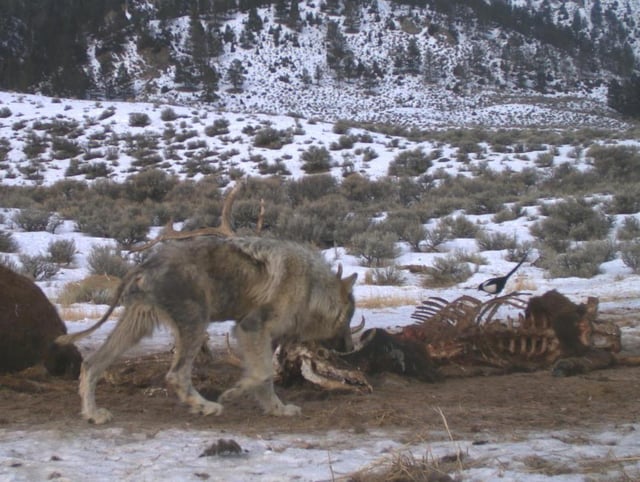
Wolf with sarcoptic mange
Wolves carry ectoparasites and endoparasites, with wolves in the former Soviet Union having been recorded to carry at least 50 species.[136] Most of these parasites infect wolves without adverse effects, though the effects may become more serious in sick or malnourished specimens.[138] Parasitic infection in wolves is of particular concern to people, as wolves can spread them to dogs, which in turn can carry the parasites to humans. In areas where wolves inhabit pastoral areas, the parasites can be spread to livestock.[136]
Wolves are often infested with a variety of arthropod exoparasites, including fleas, ticks, lice, and mites. The most harmful to wolves, particularly pups, is the mange mite (Sarcoptes scabiei),[138] though they rarely develop full-blown mange, unlike foxes.[73] Lice, such as Trichodectes canis, may cause sickness in wolves, but rarely death. Ticks of the genus Ixodes can infect wolves with Lyme disease and Rocky Mountain spotted fever.[138] The tick Dermacentor pictus also infests wolves. Other ectoparasites include chewing lice, sucking lice and the fleas Pulex irritans and Ctenocephalides canis.[73]
Endoparasites known to infect wolves include protozoans and helminths (flukes, tapeworms, roundworms and thorny-headed worms). Of 30,000 protozoan species, only a few have been recorded to infect wolves: Isospora, Toxoplasma, Sarcocystis, Babesia, and Giardia.[138] Wolves may carry Neospora caninum, which is of particular concern to farmers, as the disease can be spread to livestock, with infected animals being three to 13 times more likely to miscarry than those not infected.[139][140] Among flukes, the most common in North American wolves is Alaria, which infects small rodents and amphibians that are eaten by wolves. Upon reaching maturity, Alaria migrates to the wolf's intestine, but harms it little. Metorchis conjunctus, which enters wolves through eating fish, infects the wolf's liver or gall bladder, causing liver disease, inflammation of the pancreas, and emaciation. Most other fluke species reside in the wolf's intestine, though Paragonimus westermani lives in the lungs. Tapeworms are commonly found in wolves, as their primary hosts are ungulates, small mammals, and fish, which wolves feed upon. Tapeworms generally cause little harm in wolves, though this depends on the number and size of the parasites, and the sensitivity of the host. Symptoms often include constipation, toxic and allergic reactions, irritation of the intestinal mucosa, and malnutrition. Infections by the tapeworm Echinococcus granulosus in ungulate populations tend to increase in areas with high wolf densities, as wolves can shed Echinoccocus eggs in their feces onto grazing areas. Wolves can carry over 30 roundworm species, though most roundworm infections appear benign, depending on the number of worms and the age of the host. Ancylostoma caninum attaches itself on the intestinal wall to feed on the host's blood, and can cause hyperchromic anemia, emaciation, diarrhea, and possibly death. Toxocara canis, a hookworm known to infect wolf pups in utero, can cause intestinal irritation, bloating, vomiting, and diarrhea. Wolves may catch Dioctophyma renale from minks, which infects the kidneys, and can grow to lengths of 100 cm. D. renale causes the complete destruction of the kidney's functional tissue, and can be fatal if both kidneys are infected. Wolves can tolerate low levels of Dirofilaria immitis for many years without showing any ill effects, though high levels can kill wolves through cardiac enlargement and congestive hepatopathy. Wolves probably become infected with Trichinella spiralis by eating infected ungulates. Although T. spiralis is not known to produce clinical signs in wolves, it can cause emaciation, salivation, and crippling muscle pains in dogs. Thorny-headed worms rarely infect wolves, though three species have been identified in Russian wolves: Nicolla skrjabini, Macrocantorhynchus catulinus, and Moniliformis moniliformis.[138]
Status and conservation

Wolf in northern Rocky Mountains
The global grey wolf population was estimated to be 300,000 in the 2000s.[141] Wolf population declines have been arrested since the 1970s, and have fostered recolonization and reintroduction in parts of its former range due to legal protection, changes in land-use, and rural human population shifts to cities.
Competition with humans for livestock and game species, concerns over the danger posed by wolves to people, and habitat fragmentation pose a continued threat to the wolf.
Despite these threats, the wolf's relatively widespread range and stable population allows it to be classified as Least Concern on the IUCN Red List. The species is included in CITES Appendix II, except populations from Bhutan, India, Nepal and Pakistan, which are listed on Appendix I.[2]
North America
The gray wolf is found in approximately 80% of its historical range in Canada, thus making it an important stronghold for the species.[51] It has a healthy and stable wolf population at 50,000–60,000 and the status of the species can depend on the providence and territory.
First Nations people can hunt then without restrictions but others have to acquire licenses for hunting and trapping seasons. As many as 4,000 wolves may be harvested in Canada each year. In Alaska, the wolf population numbers 6,000–7,000 individuals and regulated hunting and trapping during seasons is permitted. It has been estimated that 15% of the population is taken each year.[142]
In the contiguous United States, wolves would be given protection on the Endangered Species Act (ESA) of 1973. By then, the only surviving populations where in Minnesota, which numbered in the several hundreds, and on Michigan's Isle Royale. With federal protection, the wolf population in Minnesota would grow to has much as 3,000 individuals by the mid 2000s and recolonized Wisconsin and the Upper Peninsula of Michigan, whose populations number in the hundreds.[143] In the late 1970s, wolves from southwestern Canada began crossing into northwestern Montana and established a denning site in Glacier National Park in 1986. In 1995, the federal government begin to reintroduce wolves to Yellowstone, were they were absent since the 1930s, and central Idaho as part of a Rocky Mountain recovery plan.[142] Since then, wolves would occupy much of the northern Rocky Mountain region, with atleast 1,704 wolves in Montana, Idaho and Wyoming in 2015, and established populations in Washington and Oregon.[144] In 2018, the wolf population in Washington was estimated at a minimum of 126.[145] In addition, a wolf pack from Oregon crossed into California in April 2019 and produced three more pups.[146]
After being listed under ESA, the United States and Mexico collaborated to capture all Mexican wolves remaining in the wild. This extreme measure prevented the their extinction. Five wild Mexican wolves (four males and one pregnant female) were captured alive in Mexico from 1977 to 1980 and used to start a captive breeding program. From this program, captive-bred Mexican wolves were released into recovery areas in Arizona and New Mexico beginning in 1998 in order to assist the animals' recolonization of their former historical range. As of 2017, there are 143 Mexican wolves living wild and 240 in captive breeding programs.[147][148]
Eurasia
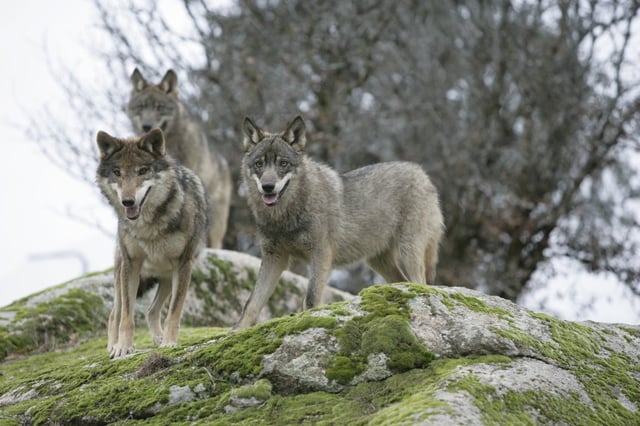
Wolves in the Iberian Peninsula
Europe, excluding Russia, Belarus and Ukraine, has 17,000 wolves in over 28 countries.[149] The species is strictly protected under the 1979 Berne Convention on the Conservation of European Wildlife and Natural Habitats (Appendix II) and the 1992 European Union Council Directive 92/43/EEC on the Conservation of Natural Habitats and of Wild Fauna and Flora (Annex II and IV), and there is extensive legal protection in many European countries; however, there are national exceptions, and enforcement is variable and often non-existent.[2] Starting around 1980, European wolves rebounded after centuries of persecution and expanded into parts of their former range. The decline of the traditional pastoral and rural economics seems to have stopped the need to exterminate the wolf in parts of Europe.[142] Strongholds of European wolves include the Balkans (around 4,000 by 2016), the Carpathian Mountains (3,460–3,849), the Baltic states (1,700–2,240), the Italian peninsula (1,100–2,400) and the northwest Iberian peninsula (around 2,500 in 2007).[150]
In the former Soviet Union, wolf populations have retained much of their historical range despite Soviet-era large scale extermination campaigns. Their numbers range from 1,500 in Georgia, to 20,000 in Kazakhstan and up to 45,000 in Russia. Most of the populations in this region appear to be stable.[151] The Russian government has continued to pay bounties for wolves and annual harvests of 20-30% do not appear to significantly affect their numbers.[152] In the Middle East, Turkey, Israel and Saudi Arabia appear to play important roles in wolf conservation in the region.[153] Turkey has a population of about 7,000 wolves, though this seem to be an overestimate.[154] Although wolves in Turkey are not legally protected, the gained status of a game species means that wolves can only be hunted with a license using established quotas which are restricted to hunting seasons.[155] Israel has protected their wolves since 1954 and has maintained a moderately-sized population though effective enforcement of conservation policies. These wolves have moved into neighboring countries. Saudi Arabia has large and mostly undistributed areas of desert and 300–600 wolves inhabit the Arabian Peninsula.[153] In addition, the wolf appears to be widespread in Iran.[156]
In South Asia, the northern regions of Afghanistan and Pakistan are important strongholds for the wolf.
It has been estimated that there are about 300 wolves in approximately 60,000 km2 (23,000 sq mi) of Jammu and Kashmir in northern India, and 50 more in Himachal Pradesh. The wolf was given protected status in India in 1972.[153] Mongolia's population numbers 10,000–20,000, while in China; Heilongjiang has roughly 650 wolves, Xinjiang has 10,000 and Tibet has 2,000.[157] More recent evidence suggests the wolf range extends across all of mainland China.[4][5][6]
Relationships with humans
In culture
In mythology and folklore

Capitoline Wolf, sculpture of the mythical she-wolf feeding the twins Romulus and Remus, from the legend of the founding of Rome, Italy.
The wolf is a common motif in the mythologies and cosmologies of peoples throughout its historical range.
The Ancient Greeks associated wolves with Apollo, the god of light and order.[158] The Ancient Romans connected the wolf with their god of war and agriculture Mars,[159] and believed their founders Romulus and Remus were suckled by a she-wolf.[160] Norse mythology includes the feared giant wolf Fenrir, eldest child of Loki and Angrboda,[161] and Geri and Freki, Odin's faithful pets.[162] In the Pawnee creation myth, the wolf was the first animal brought to earth and when humans killed it, they were punished with death, destruction and the loss of immortality.[163] For the Pawnee, Sirius was the "wolf star" and its disappearance and reappearance signified the wolf moving to and from the spirit world. Both the Pawnee and Blackfoot called the Milky Way the "wolf trail".[164] In Chinese astronomy, the wolf represents Sirius as the "blue beast" and the star itself is called the "heavenly wolf".[165]
The concept of people turning into wolves has been present in many cultures.
One Greek myth tells of Lycaon of Arcadia being transformed into a wolf by Zeus as punishment for his evil deeds.[166] The legend of the werewolf has been widespread in European folklore and involves people willingly turning into wolves to attack and kill others.[167] The Navajo have traditionally believed that witches would turn into wolves by donning wolf skins and would kill people and raid graveyards.[168] The Dena’ina believed wolves were once men, and viewed them as brothers.[158]
In fable and literature
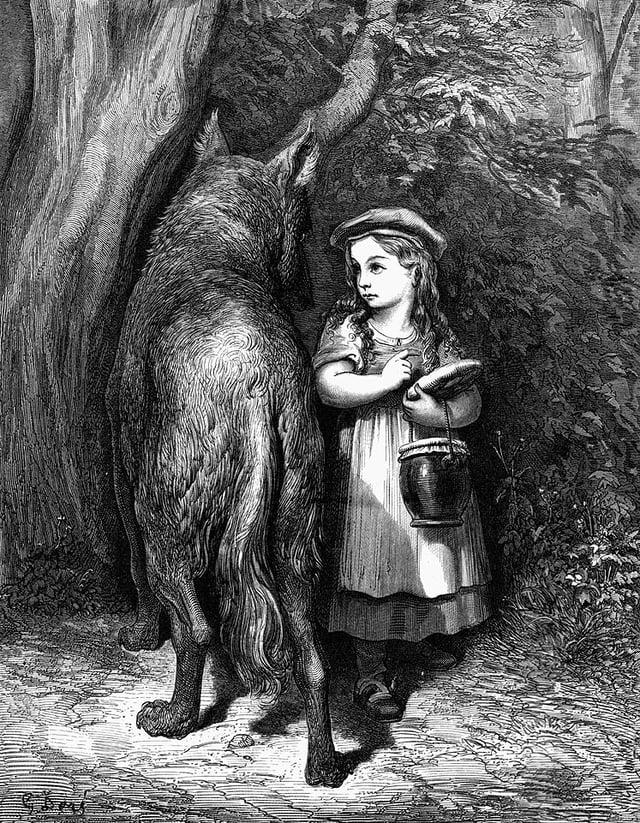
Little Red Riding Hood (1883), Gustave Doré
Aesop featured wolves in several of his fables, playing on the concerns of Ancient Greece's settled, sheep-herding world. His most famous is the fable of "The Boy Who Cried Wolf", which is directed at those who knowingly raise false alarms, and from which the idiomatic phrase "to cry wolf" is derived. Some of his other fables concentrate on maintaining the trust between shepherds and guard dogs in their vigilance against wolves, as well as anxieties over the close relationship between wolves and dogs. Although Aesop used wolves to warn, criticize and moralize about human behavior, his portrayals added to the wolf's image as a deceitful and dangerous animal.[169] The Bible contains 13 references to wolves, usually as metaphors for greed and destructiveness. In the New Testament, Jesus is quoted to have used wolves as illustrations to the dangers his followers, whom he represents as sheep, would face should they follow him (Matthew 7:15 [222], Matthew 10:16 [223], Acts 20:29 [224] ).[170]Beasts%20of%20the%20Field%3A%20The%20]]Isengrim the wolf, a character first appearing in the 12th-century Latin poem Ysengrimus Reynard here he stands for the low nobility, whilst his adversary, Reynard the fox, represents the peasant hero. Although portrayed as loyal, honest and moral, Isengrim is forever the victim of Reynard's wit and cruelty, often dying at the end of each story.[171]
The tale of Little Red Riding Hood, first written in 1697 by Charles Perrault, is largely considered to have had more influence than any other source of literature in forging the wolf's negative reputation in the western world. The wolf in this story is portrayed as a sexual predator, capable of imitating human speech.[172] Similar wolf characters appear in The Three Little Pigs and The Wolf and the Seven Young Goats.[173] The hunting of wolves, and their attacks on humans and livestock feature prominently in Russian literature, and are included in the works of Tolstoy, Chekhov, Nekrasov, Bunin, Sabaneyev, and others. Tolstoy's War and Peace and Chekhov's Peasants both feature scenes in which wolves are hunted with hounds and Borzois.[174] Wolves are among the central characters of Rudyard Kipling's The Jungle Book, and his portrayal of wolves has been praised posthumously by wolf biologists for his depiction of them: rather than being villanous or gluttonous, as was common in wolf portrayals at the time of the book's publication, they are shown as living in amiable family groups and drawing on the experience of infirm but experienced elder pack members. The wolf's motto of "For the strength of the Wolf is the Pack, and the strength of the Pack is the Wolf" has also been confirmed in field studies, which show that success rates in hunting and repelling intruders are dependent on pack size and the number of adult males or old wolves.[175] Farley Mowat's largely fictional 1963 memoir Never Cry Wolf is largely considered to be the most popular book on wolves, having been adapted into a Hollywood film and taught in several schools decades after its publication. Although credited with having changed popular perceptions on wolves by portraying them as loving, cooperative and noble, it has been criticized for its idealization of wolves and its factual inaccuracies.[176][177][178]
In heraldry and symbolism

Pawnee Nation of Oklahoma tribal flag
The wolf is a frequent charge in English armory. It is illustrated as a supporter on the shields of Lord Welby, Rendel, and Viscount Wolseley, and can be found on the coat of arms of Lovett and the vast majority of the Wilsons and Lows. The demi-wolf is a common crest, appearing in the arms and crests of members of many families, including that of the Wolfes, whose crest depicts a demi-wolf holding a crown in its paws, in reference to the assistance the family gave to Charles II during the battle of Worcester. Wolf heads are common in Scottish heraldry, particularly in the coats of Clan Robertson and Skene. The wolf is the most common animal in Spanish heraldry, and is often depicted as carrying a lamb in its mouth, or across its back.[179] The wolf is featured on the flags of the Confederated Tribes of the Colville Reservation, the Oneida Nation of Wisconsin and the Pawnee.[180] The Chechen wolf has been a symbol of the Chechen Nation.[181] In modern times, the wolf is widely used as an emblem for military and paramilitary groups. It is the unofficial symbol of the spetsnaz, and serves as the logo of the Turkish Grey Wolves. During the Yugoslav Wars, several Serb paramilitary units adopted the wolf as their symbol, including the White Wolves and the Wolves of Vučjak.[182]
Conflicts

Waiting for a Chinook (c. 1900), Charles Marion Russell
Human presence appears to stress wolves, as seen by increased cortisol levels in instances such as snowmobiling near their territory.[183]
Wolf predation on livestock
Livestock depredation has been one of the primary reasons for hunting wolves, and can pose a severe problem for wolf conservation: as well as causing economic losses, the threat of wolf predation causes great stress on livestock producers, and no foolproof solution of preventing such attacks short of exterminating wolves has been found.[184] Some nations help offset economic losses to wolves through compensation programmes or state insurance.[185] Domesticated animals are easy prey for wolves, as they have evolved under constant human protection, and are thus unable to defend themselves very well.[186] Wolves typically resort to attacking livestock when wild prey is depleted: in Eurasia, a large part of the diet of some wolf populations consists of livestock, while such incidents are rare in North America, where healthy populations of wild prey have been largely restored.[184] The majority of losses occur during the summer grazing period, with untended livestock in remote pastures being the most vulnerable to wolf predation.[187] The most frequently targeted livestock species are sheep (Europe), domestic reindeer (northern Scandinavia), goats (India), horses (Mongolia), cattle and turkeys (North America).[184] The number of animals killed in single attacks varies according to species: most attacks on cattle and horses result in one death, while turkeys, sheep and domestic reindeer may be killed in surplus.[188] Wolves mainly attack livestock when the animals are grazing, though they occasionally break into fenced enclosures.[110] In some cases, wolves do not need to physically attack livestock to negatively affect it: the stress livestock experiences in being vigilant for wolves may result in miscarriages, weight loss and a decrease in meat quality.[139]
Conflicts with dogs
Being the most abundant carnivores, free-ranging dogs have the greatest potential to compete with wolves. A review of the studies in the competitive effects of dogs on sympatric carnivores did not mention any research on competition between dogs and wolves.[189][190] Competition would favor the wolf, which is known to kill dogs, however wolves tend to live in pairs or in small packs in areas where they are highly persecuted, giving them a disadvantage facing large groups of dogs.[190][191]
Wolves kill dogs on occasion, with some wolf populations relying on dogs as an important food source.
In Croatia, wolves kill more dogs than sheep, and wolves in Russia appear to limit stray dog populations.
Wolves may display unusually bold behavior when attacking dogs accompanied by people, sometimes ignoring nearby humans.[184] Wolf attacks on dogs may occur both in house yards and in forests.[192] Wolf attacks on hunting dogs are considered a major problem in Scandinavia and Wisconsin.[184][192] The most frequently killed hunting breeds in Scandinavia are harriers, with older animals being most at risk, likely because they are less timid than younger animals, and react to the presence of wolves differently. Large hunting dogs such as Swedish elkhounds are more likely to survive wolf attacks because of their better ability to defend themselves.[192]
Although the numbers of dogs killed each year are relatively low, it induces a fear of wolves entering villages and farmyards to take dogs.
In many cultures, there are strong social and emotional bonds between humans and their dogs that can be seen as family members or working team members.
The loss of a dog can lead to strong emotional responses with demands for more liberal wolf hunting regulations.[190]
Dogs that are employed to guard sheep help to mitigate human–wolf conflicts, and are often proposed as one of the non-lethal tools in the conservation of wolves.[190][193] Shepherd dogs are not particularly aggressive, but they can disrupt potential wolf predation by displaying what is to the wolf ambiguous behaviors, such as barking, social greeting, invitation to play or aggression.[190][194] The historical use of shepherd dogs across Eurasia has been effective against wolf predation,[190][194] especially when confining sheep in the presence of several livestock guardian dogs.[190][195] However, shepherd dogs are sometimes killed by wolves.[190][196]
Wolf attacks on humans
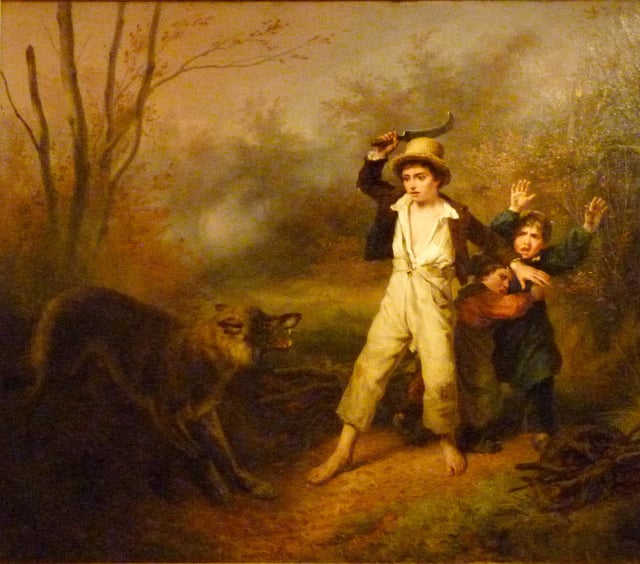
Small farmers surprised by a wolf (1833) by François Grenier de Saint-Martin
The fear of wolves has been pervasive in many societies, though humans are not part of the wolf's natural prey.[197] How wolves react to humans depends largely on their prior experience with people: wolves lacking any negative experience of humans, or which are food-conditioned, may show little fear of people.[198] Although wolves may react aggressively under provocation, such attacks are mostly limited to quick bites on extremities, and the attacks are not pressed.[197]
Predatory attacks (attacks by wolves treating humans as food) may be preceded by a long period of habituation, in which wolves gradually lose their fear of humans. The victims are repeatedly bitten on the head and face, and are then dragged off and consumed, unless the wolves are driven off. Such attacks typically occur only locally, and do not stop until the wolves involved are eliminated. Predatory attacks can occur at any time of the year, with a peak in the June–August period, when the chances of people entering forested areas (for livestock grazing or berry and mushroom picking) increase,[197] though cases of non-rabid wolf attacks in winter have been recorded in Belarus, Kirov and Irkutsk oblasts, Karelia and Ukraine.[73] Also, wolves with pups experience greater food stresses during this period.[73] The majority of victims of predatory wolf attacks are children under the age of 18 and, in the rare cases where adults are killed, the victims are almost always women.[197]
Cases of rabid wolves are low when compared to other species, as wolves do not serve as primary reservoirs of the disease, but can be infected by animals such as dogs, jackals and foxes. Incidents of rabies in wolves are very rare in North America, though numerous in the eastern Mediterranean, Middle East and Central Asia. Wolves apparently develop the "furious" phase of rabies to a very high degree which, coupled with their size and strength, makes rabid wolves perhaps the most dangerous of rabid animals,[197] with bites from rabid wolves being 15 times more dangerous than those of rabid dogs.[73] Rabid wolves usually act alone, travelling large distances and often biting large numbers of people and domestic animals. Most rabid wolf attacks occur in the spring and autumn periods. Unlike with predatory attacks, the victims of rabid wolves are not eaten, and the attacks generally only occur on a single day. The victims are chosen at random, though the majority of cases involve adult men. During the 50 years to 2002, there were eight fatal attacks in Europe and Russia, and more than 200 in southern Asia.[197]
Human hunting of wolves
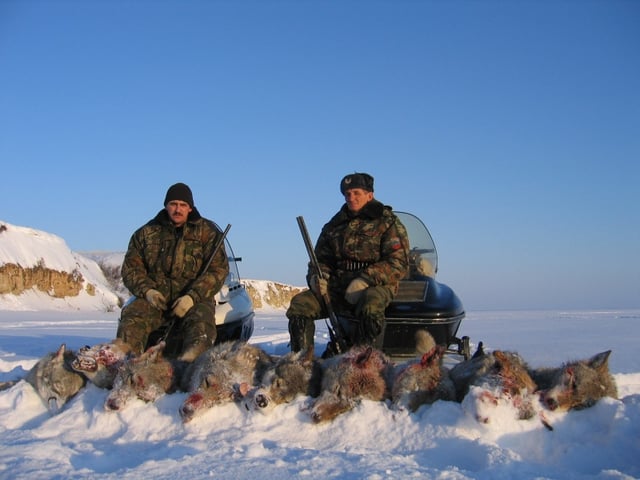
Carcasses of hunted wolves in Russia
Theodore Roosevelt stated that wolves are difficult to hunt because of their elusiveness, sharp senses, high endurance, and ability to quickly incapacitate and kill hunting dogs.[199] Historic methods include killing of spring-born litters in their dens, coursing with dogs (usually combinations of sighthounds, bloodhounds and fox terriers), poisoning with strychnine, and trapping.[200][201] A popular method of wolf hunting in Russia involves trapping a pack within a small area by encircling it with fladry poles carrying a human scent. This method relies heavily on the wolf's fear of human scents, though it can lose its effectiveness when wolves become accustomed to the smell. Some hunters are able to lure wolves by imitating their calls. In Kazakhstan and Mongolia, wolves are traditionally hunted with eagles and falcons, though this practice is declining, as experienced falconers are becoming few in number. Shooting wolves from aircraft is highly effective, due to increased visibility and direct lines of fire,[201] but is controversial.[202] Several types of dog, including the Borzoi and Kyrgyz Tajgan, have been specifically bred for wolf hunting.[190]
As pets and working animals
Wild wolves are sometimes kept as exotic pets and, in some rarer occasions, as working animals. Although closely related to domesticated dogs, wolves do not show the same tractability as dogs in living alongside humans, and generally, much more work is required in order to obtain the same amount of reliability. Wolves also need much more space than dogs, about 26–39 square kilometres (10–15 sq mi), so they can exercise.[203]